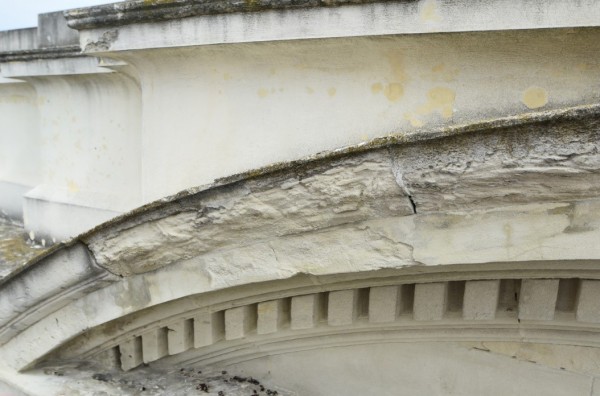Building Stone: Testing for Durability
Building stone, or dimensional stone, is a natural product. As such, there is a risk that it may have natural flaws, variations, and defects that affect how it performs in a building.
Variations
A variation may be as minor as a slight color difference or as major as a serious structural fault. In worst-case scenarios, stone may need to be replaced in as little as 10 years.
It is important to know, as far as practicable, that a building stone is going to perform as expected and is durable.
The qualities of a building stone, including its durability, are determined by how it was formed.

Stone Types
- Igneous – stone that is formed by the cooling of magma.
- Sedimentary – stone that is formed by the accumulation of existing fragments of rock, or biological material (shells, for example), or by the chemical precipitation of sediments.
- Metamorphic – the alteration of igneous or sedimentary stone by intense heat and pressure.
Durable Stone Types
Dense stone types, such as igneous and many examples of metamorphic, are generally very durable. Basalt (bluestone) and granite are good examples of dense stone types that are highly durable.
There is little concern that buildings constructed from this type of stone will suffer from extreme weathering and deterioration.
Sedimentary Stone
Sedimentary stone is generally the least dense stone type. This is because it is porous, having voids amongst its constituent particles due to how it was formed.
Being permeable means that the pores within the stone are interlinked and water can migrate through the stone relatively easily. It is the migration of water-carrying soluble salts that is the main factor in a building stone deteriorating.
Soluble Salts
Soluble Salts are ionic compounds that dissociate their constituents in a solvent such as water. In essence, they dissolve, move whilst in solution and then re-crystalise.
Sedimentary limestones are inherently susceptible to soluble salts as they largely consist of calcium carbonate, which will break down when in contact with acids converting them to sulphates; these are the most common salts found in masonry.
There are also many other sources of damaging salts that can find their way into a building stone:
- those naturally occurring in groundwater
- sea spray near the coast
- those delivered by flooding or defective underground pipes
- those that are derived from fertilisers or sands used in mortars that haven’t been thoroughly washed
- pollution
- acid rain
- modern cements.
Many factors can lead to the deterioration of a building stone, but it is the action of salts that is the primary mechanism when considering durability.
At drying zones, which are typically at or just beneath the surface of the stone, salts in solution form crystals that have the ability to expand within the pores of the stone, blowing them apart. Some examples are shown in the photographs.
Testing for durability

Testing for durability is done by emulating this natural process of salt attack, and is called the resistance to salt attack, or durability test.
In an accredited materials testing laboratory, 50mm cubes are saturated in a solution of salt and then dried in an oven. This process is repeated over 21 cycles to represent long-term weathering in a built environment.
After the cycles of wetting and drying are complete, a comparison in weight is made between the cubes at the start and at the end of the process. The measurement is taken in terms of the percentage of weight loss.
A weak stone will have a high percentage of weight loss (material lost by the action of salts) than a more durable stone.
There is usually a strong correlation between density, water absorption, and resistance to salt attack.
Because the resistance to salt attack test requires considerable time and cost, testing for density and water absorption alone can be a quicker way of establishing the stone’s durability. This can be done only after the parameters have been discovered through rigorous testing and a quality assurance programme has been set up.
Oamaru Stone
Oamaru stone is a good example of a porous sedimentary stone that is susceptible to weathering and salt attack.
Oamaru stone has been formed at a relatively shallow depth, without the intense pressure that creates the denser sedimentary stones. This being the case, there are examples of very durable building stones being produced from the region.

To be confident that a stone is going to be durable for a building project, testing is highly recommended. For conservation work on buildings with high heritage value, testing should be considered a prerequisite.





